Thomas Grønnemark has made a name for himself after specializing in throw-ins after spending 20 years as a throw-in coach. In that period, he is most well known for helping Liverpool win the Premier League and the UEFA Champions League. There is a long list of clubs he has improved through his work in throw-ins, and more specifically, this article focuses on two of the sides he helped this season. Wisła Kraków, although being in the second tier, managed to win the Polish Cup dramatically. At the same time, Danish side Kolding IF are currently third in the second tier of Danish football after being newly promoted last season.
Feel free to check out his website, where he offers throw-in coaching courses, or his YouTube channel, where he goes into further detail about how to coach/execute different types of throw-ins and analysis of different teams and their throw-in performances in key games.
This tactical analysis delves into the strategic movements and advantages that Grønnemark imparts to the teams he assists through his philosophy of separating throw-ins into three different types: The Long, Fast, and Clever Throw-in. This set-piece analysis will explore the various types of throw-ins and the specific routines employed for each. Additionally, the analysis will examine how the unique skill sets of individual players influence the tactics utilised for different throw-ins.
Creating Separation
Before executing a throw-in, it is crucial that the intended recipient finds open space to effectively control the ball and sustain the attack. Similar to other set plays, there are various strategies for the recipient to create the necessary space, allowing them to secure the ball and maintain possession.
One way in which this can be done is through changing the starting position prior to the throw being taken. The player receiving the ball starts behind the defender, staying out of sight, before making a quick run into the space in front of the defender. Due to the work on timing the run, the throw is made as the receiver begins his movement, meaning that the ball and player arrive in space at the same time, giving the attacker the couple of yards of space he needs to get control of the ball.
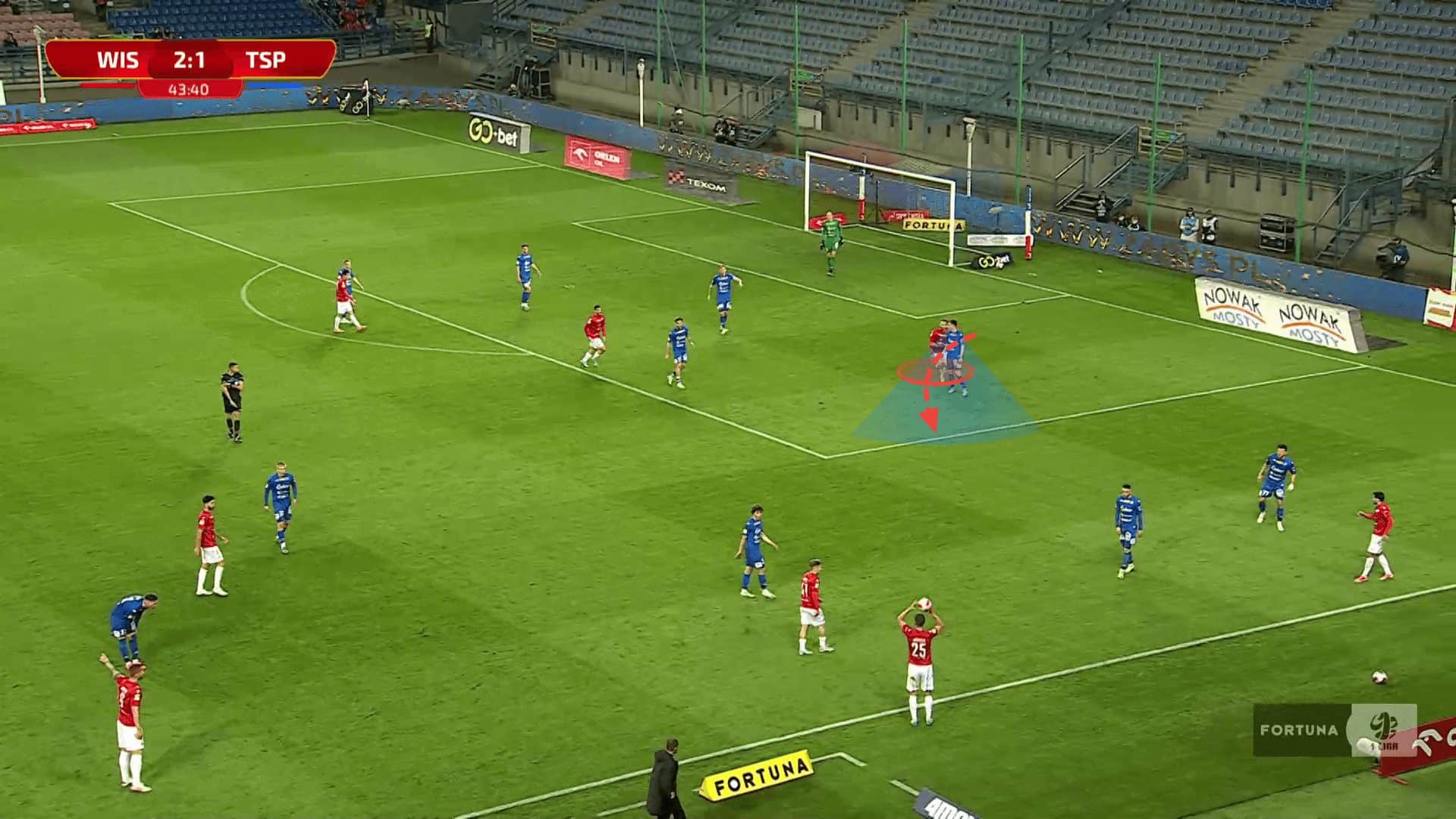
The second method which has been used to create the maximum amount of space is the use of screens. We can see in the example below that one player sets a screen for his teammate to have all the time he needs to get control of the ball.

The Long Throw-In
One of the throw-ins that Grønnemark has been able to coach to his players is the long, flat throw that can travel a long distance in a shorter period of time. The fastest way to get somewhere is by going directly in a straight line, and almost all long throw-ins that we see involve the ball flying at a high arc, where it spends several seconds in the air, giving opponents ample time to move and get in the right position. The throw in the picture below is able to travel from the throw-taker to the centre of the pitch almost immediately. The throw is aimed toward the ground, meaning it doesn’t waste time in getting to the receiver, and by the time it gets to the player, it is already on the floor and easy to control.
Executing this type of throw is difficult and extremely rare in football, showing why Grønnemark should be valued so highly across the professional sphere.
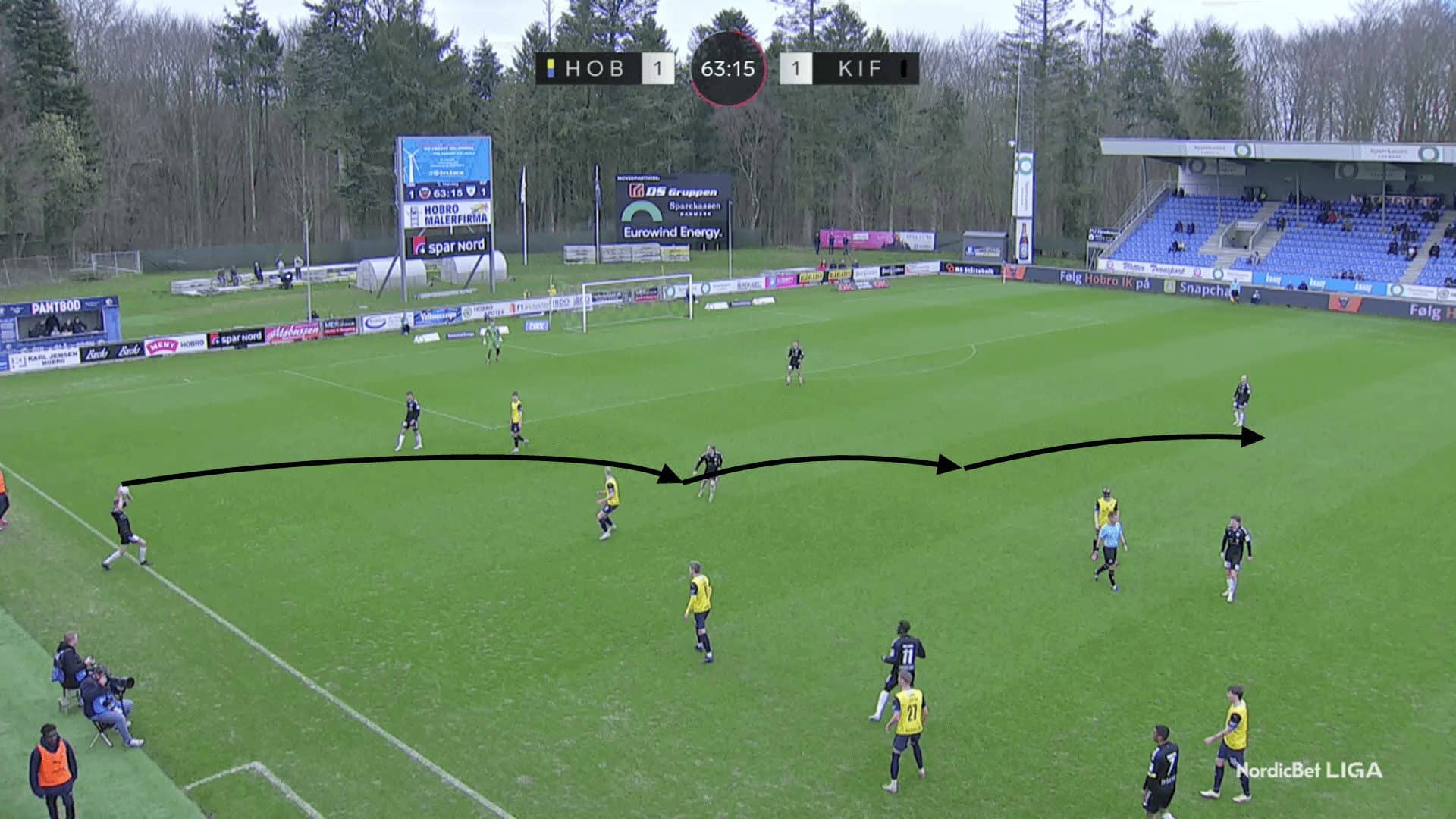
Within four seconds, Kolding IF are able to transition from a throw-in into a situation where a player is running at the last line and has the possibility to release his winger for a 1v1 situation. If the throw had been travelled at a higher angle, the recipient would not have had as much space as he did to drive up the pitch with the ball, as the defender would have been closer, and there would have been a risk of the player not getting the ball under control. The flat throw allows Grønnemark’s players to receive the ball with ease and use their first touch to attack the ball, whether they are 5 yards away from the sideline or 25.
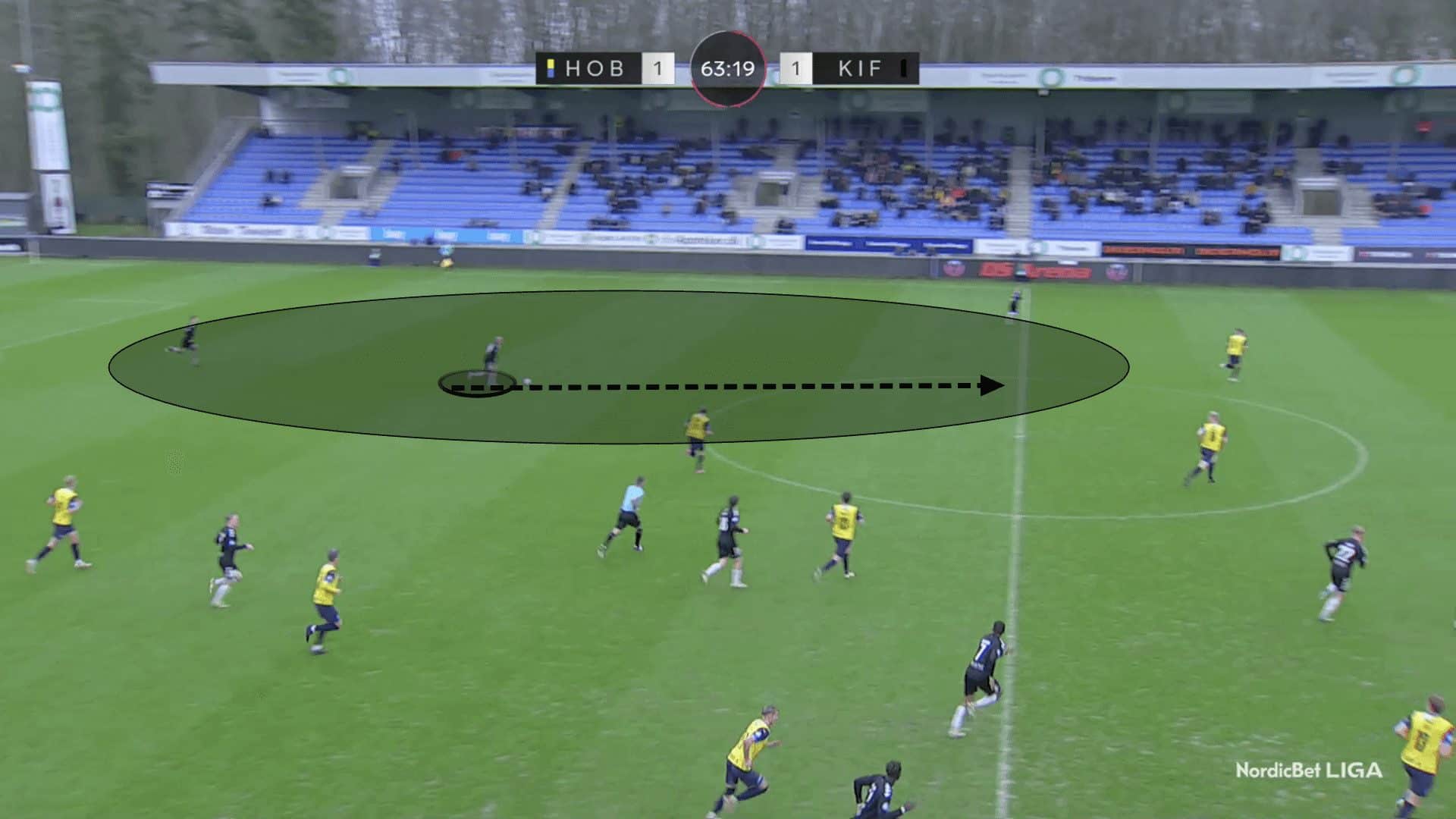
Another skill that Grønnemark gifts his players is the ability to increase the distance at which they can throw the ball. When the throw is in the attacking third, as we will discuss later, the increased distance allows teams to make the first contact closer to the goal. Another and equally important benefit is the increased number of potential receivers.
If the furthest a player can throw a ball is 10 yards, there is a 39-yard (square units) area in which the ball can land in, where there may only be two or three teammates located in, giving the throw-taker limited passing options. However, the Danish coach is able to increase the distance by an additional 10 yards through his coaching, giving the player a 20-yard throw, where the throw-in taker can now potentially throw the ball anywhere in an area of 157 yards (square units). These numbers don’t really mean anything at the moment but are just here to show that the increased throw distance can give you five times as many different possible landing points for the ball and increase the potential number of teammates you can throw the ball to, making each throw-in more unpredictable and harder to defend against.
With that being said, we can see in the image below that a throw taken from the halfway line is able to nearly reach the edge of the opposition penalty area, immediately forcing the defending side to retreat to their own penalty area. With the potential of offsides out of the picture, the defence must drop to a deep position while the rest of the team is still near the ball, preventing any options from receiving the ball through a short throw. This increases the distance between the two lines of the defensive team, which gives Kolding a lot of room to play in between the lines. Through a simple lay-off from the striker, Kolding IF are able to bypass the opposition mid-block and place the ball in front of the defensive line, where the player is able to attempt to take on a defender and enter the box. Without the long throw, the opposition could place their line at a higher point and decrease the amount of space Kolding IF have to play in between the lines, without any threat of the ball arriving behind the defensive line.
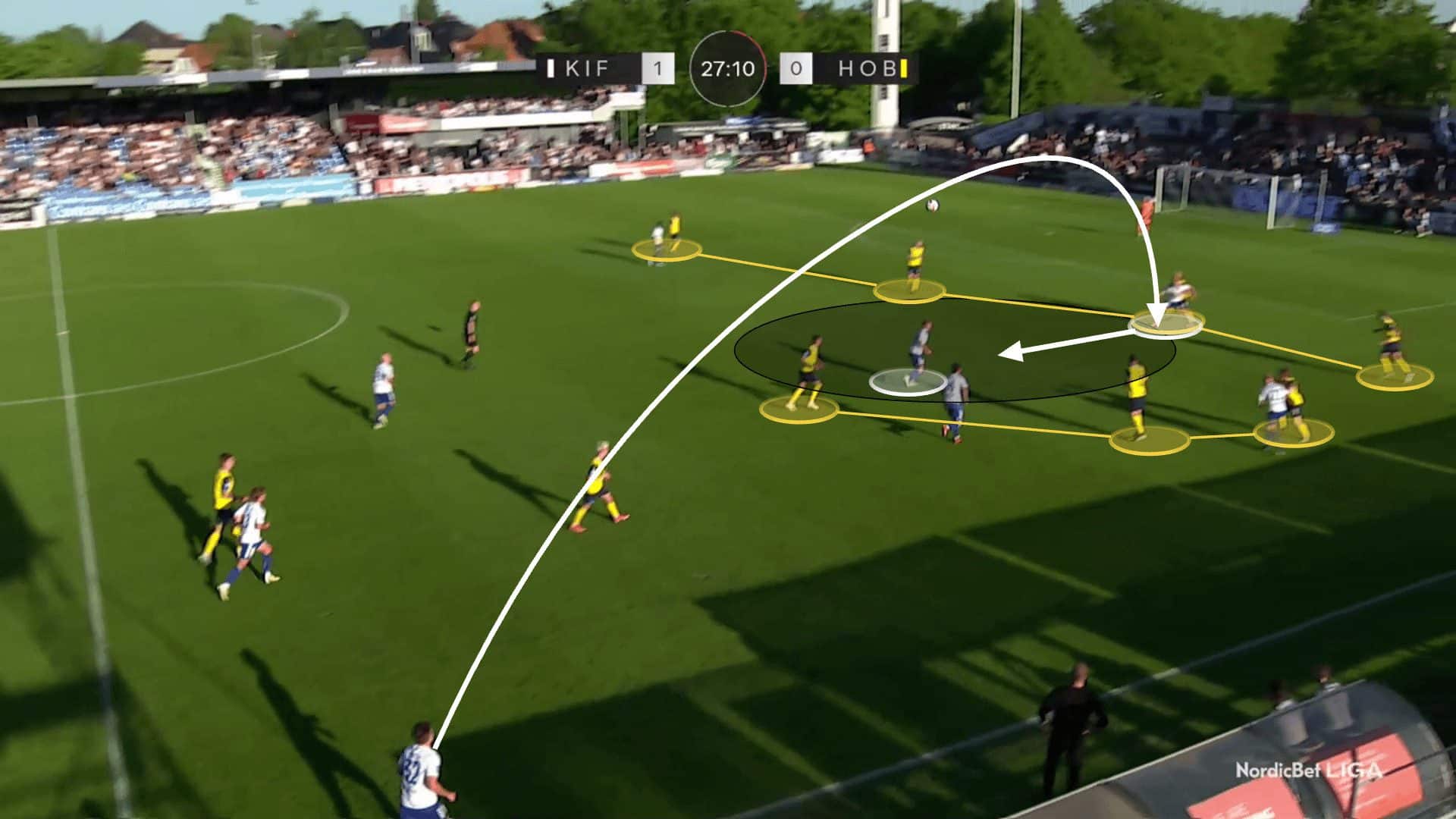
As mentioned earlier, the long throw gives Kolding IF the opportunity to throw the ball into the six-yard box, where any sort of contact on the ball could be extremely dangerous. In order to create space in the target area highlighted below, decoy runs are used to drag defenders away from the space. The run across the front of the defenders is made, which lures the defenders to vacate their position so the attackers have additional space to receive the ball.
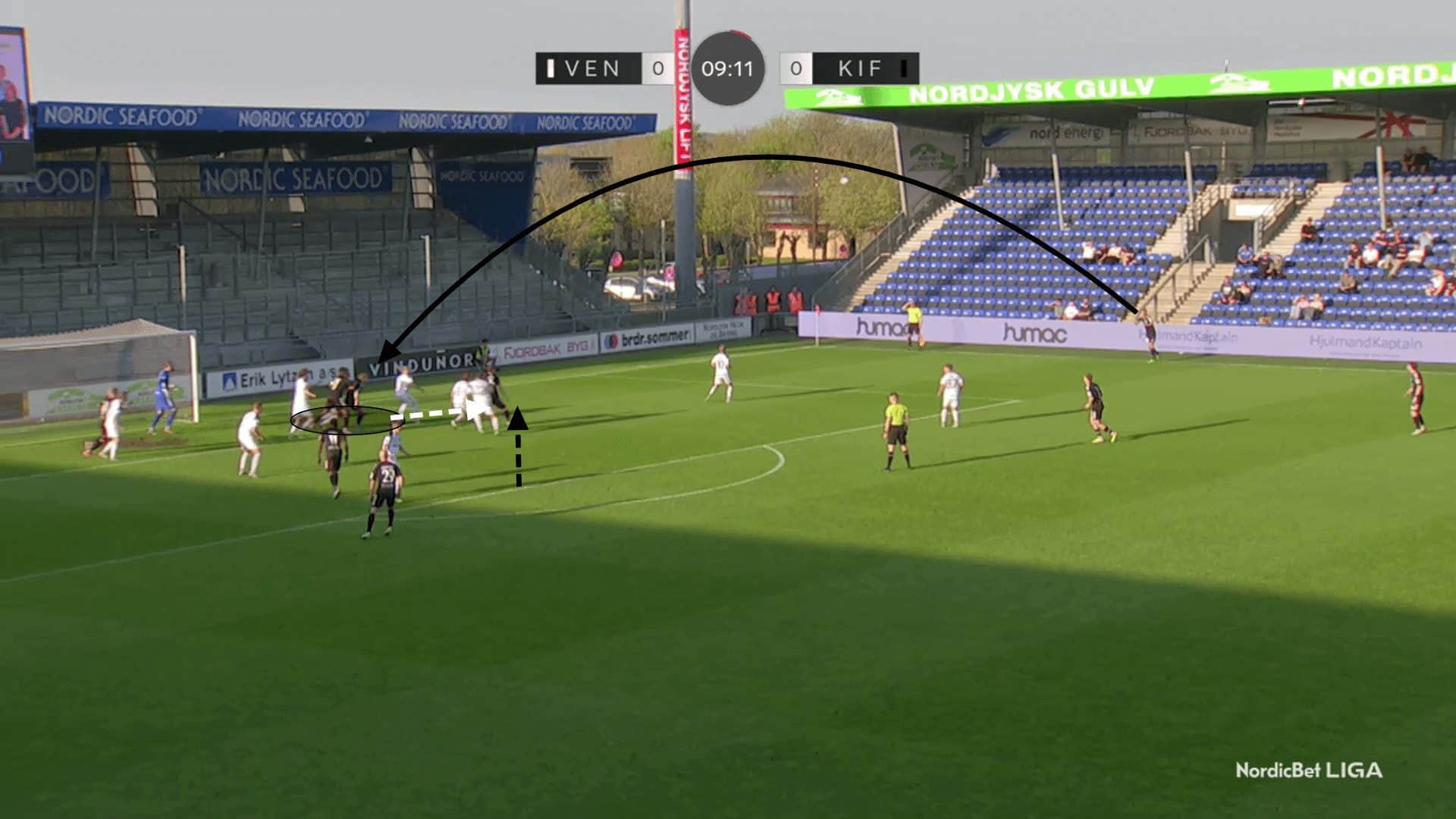
From this dangerous position inside the six-yard box, the attackers are able to make the first contact, using their body to prevent the defenders from behind them to access the target area. Due to the trajectory of the cross, there isn’t enough speed for the ball to be flicked on past the keeper, and the static positions of the attackers means they can’t generate the power either. As a result, the first contact must redirect the ball into a different area inside the penalty area. There is space deeper, around the penalty spot, where the ball is redirected, and the player arriving from the edge of the box can attack the ball and generate enough power on the ball to beat the keeper.
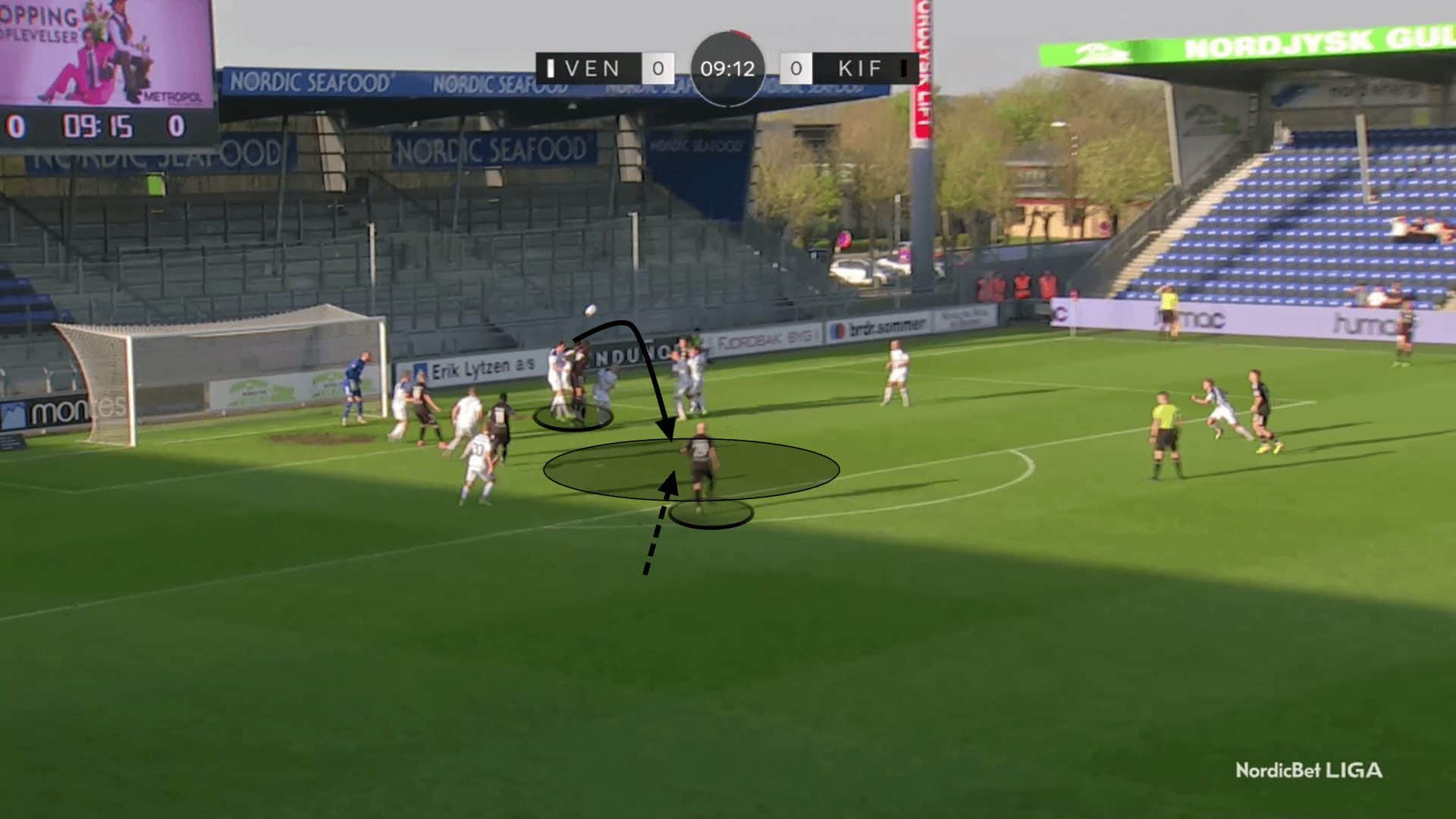
The threat of the long throw forces the defending side to retreat into their box. We can see in the image below that seven outfield opposition players are surrounding the penalty area to protect it against the long throw and potential second balls, with an extra player looking over his shoulder to determine the threat. This means that there are only two or three opponents left to cover the rest of the attacking half, which Kolding could potentially target. Having the threat gives each player much more space to move in, and as a result, these short throws can be made to areas around the penalty area, from where crosses can be made.
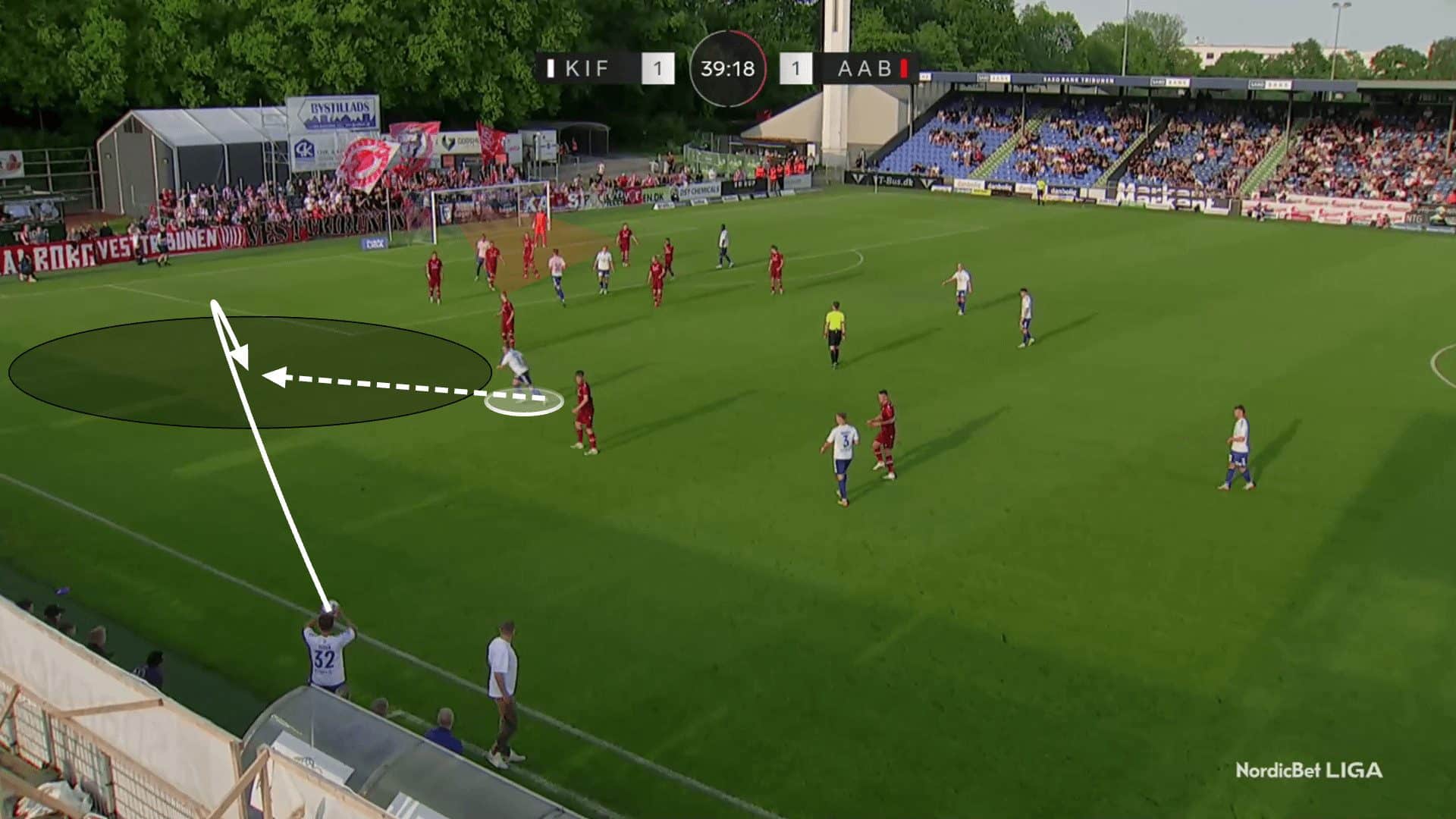
The Fast Throw-in
Being able to react quickly following throw-ins gives the attacking side two main benefits. Firstly, it is possible to catch opponents off guard. As we see in the image below, the ball has only just gone out of play, and the player instantly picks it up to put the ball back into play. With the throw made so quickly, defenders can be caught walking, not expecting the play to restart quickly. No one reacts quick enough to mark the open play, so the quick throw enables Kolding to find space on the edge of the opposition penalty area.
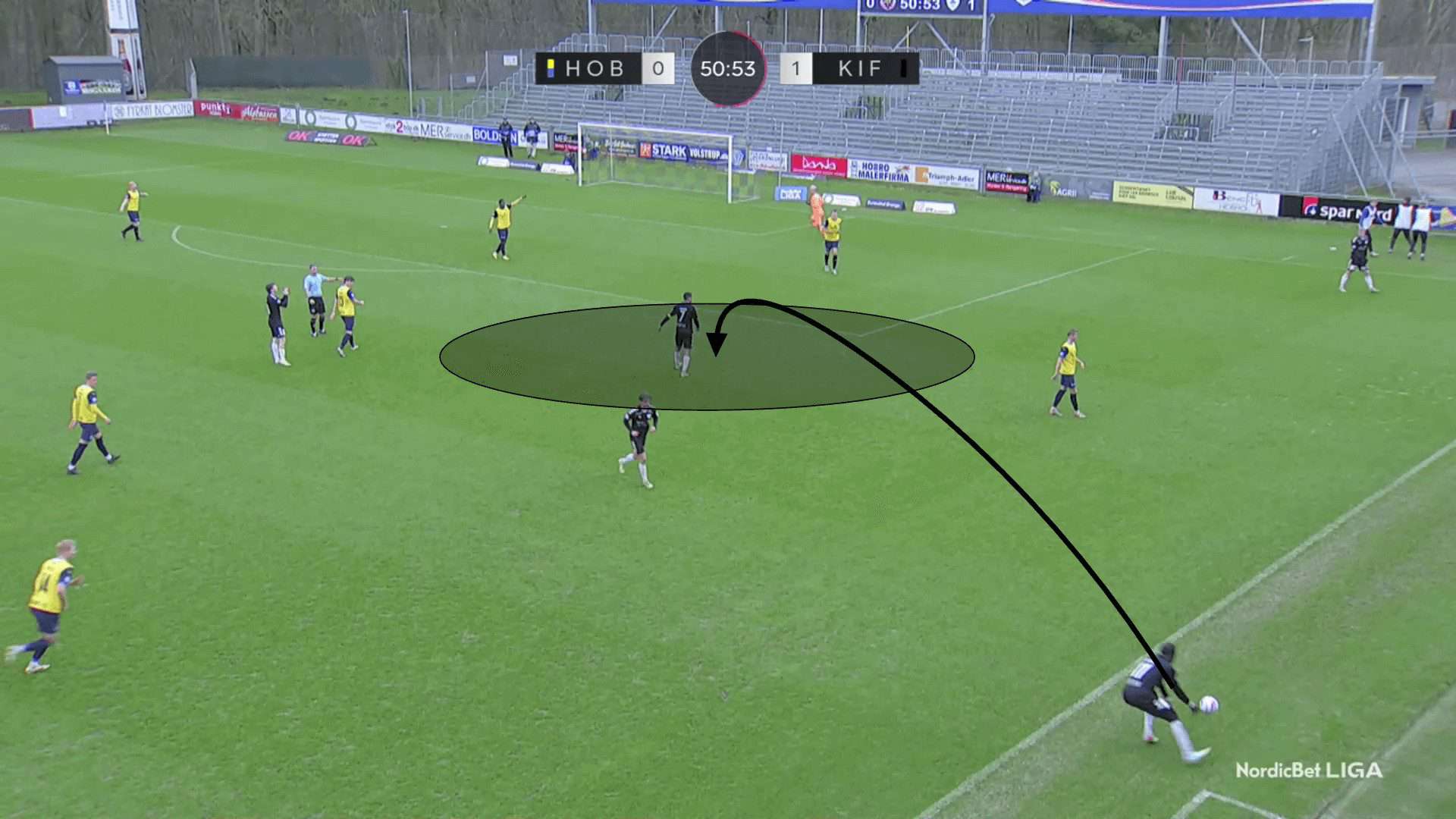
It’s also important to remember that you cannot be offside from a throw-in. This gives players like Poulsen, who was coached by Grønnemark, the idea to instantly restart play when defenders might forget what the rules are and allow the players behind them to stay unmarked. Attackers can ‘cheat’ by waiting in a higher area, where they receive the ball and are able to turn and attack the goal head-on.
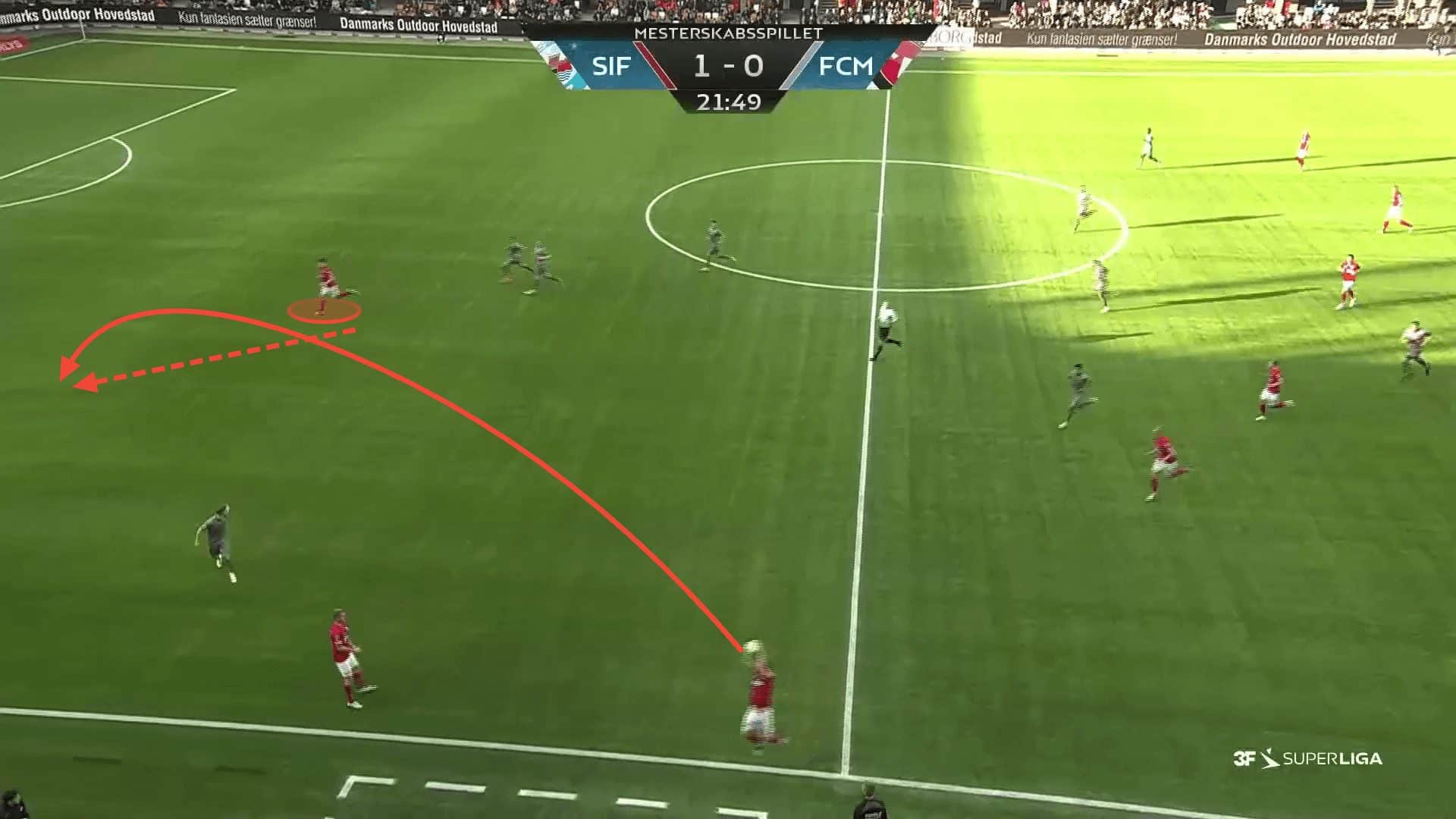
The Clever Throw-In
The last type of throw-in is based on the quick and smart movements and patterns, which are only possible through coordinated and well-thought-out routines. In order for this type of throw to be effective, Grønnemark emphasises throwing the ball to a player’s feet, where they are able to instantly play the ball to their teammate without players wasting time on adjusting their position to then play the pass.
One routine that can be taken from basketball is referred to as a ‘pick and roll’, where in the example below, we can see the player highlighted pretending that he wants the ball, but as soon as the throw is made over his head, the player turns to attack the space in front of him. At the same time, a second teammate positions himself in a deeper area, knowing the ball will come to him so that he can lay it off for his teammate. When the throw goes over the first player’s head, his marker might lose concentration while thinking his job is done, which gives the player the space he needs to receive the layoff and drive toward goal without pressure.
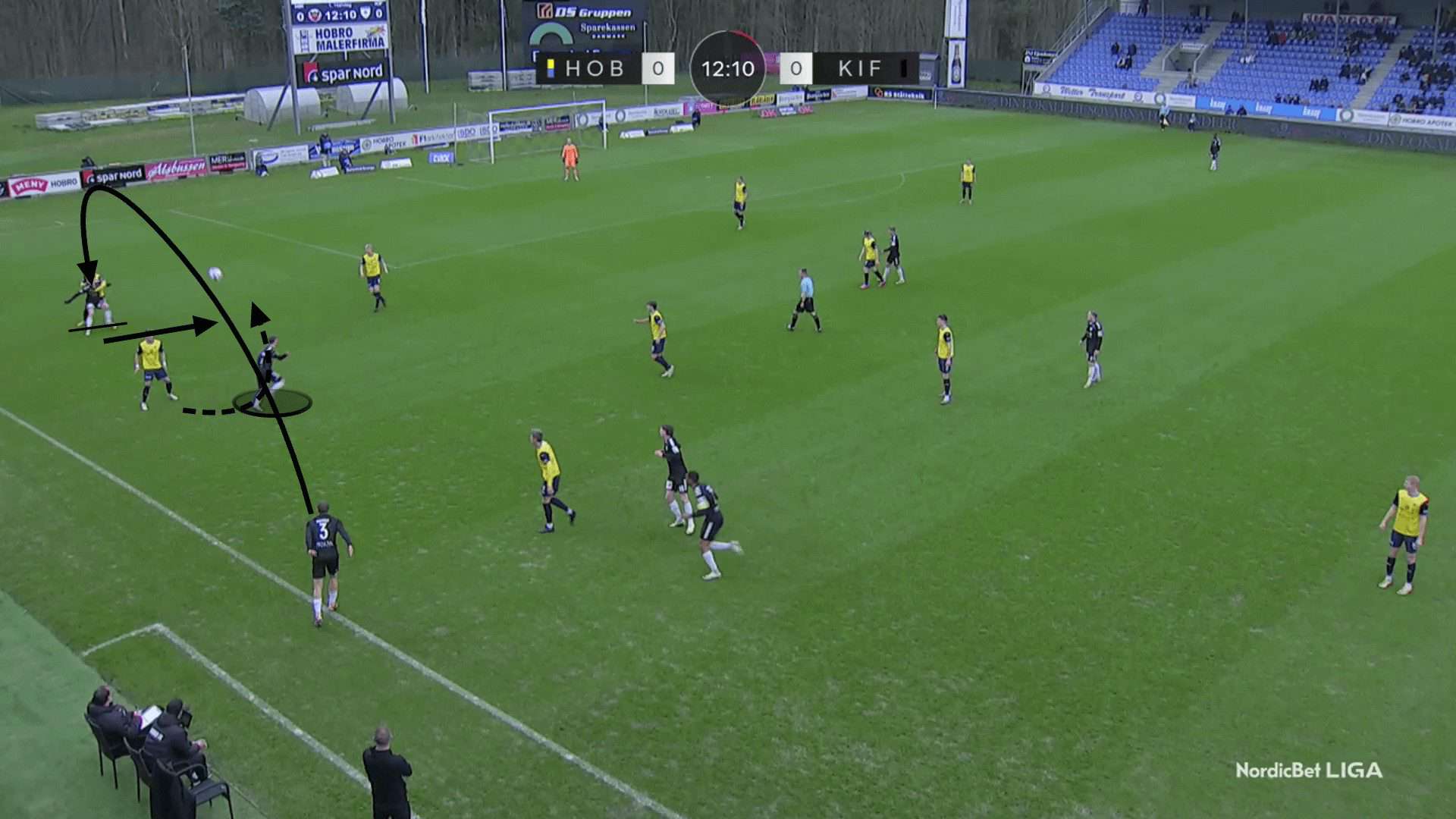
At Wisła Kraków, we can see more elaborate third-man run combinations being made to unlock space inside the opposition’s heart. The recipient arrives from the blindside to have the time needed to execute his layoff. As the ball is moving towards the goal, the opposition midfielder moves back to be in position to cover for his midfield partners. This is exactly what Wisła Kraków are looking for, as they want the forward-facing player to have time and space to perform the forward, incisive pass without disruption.
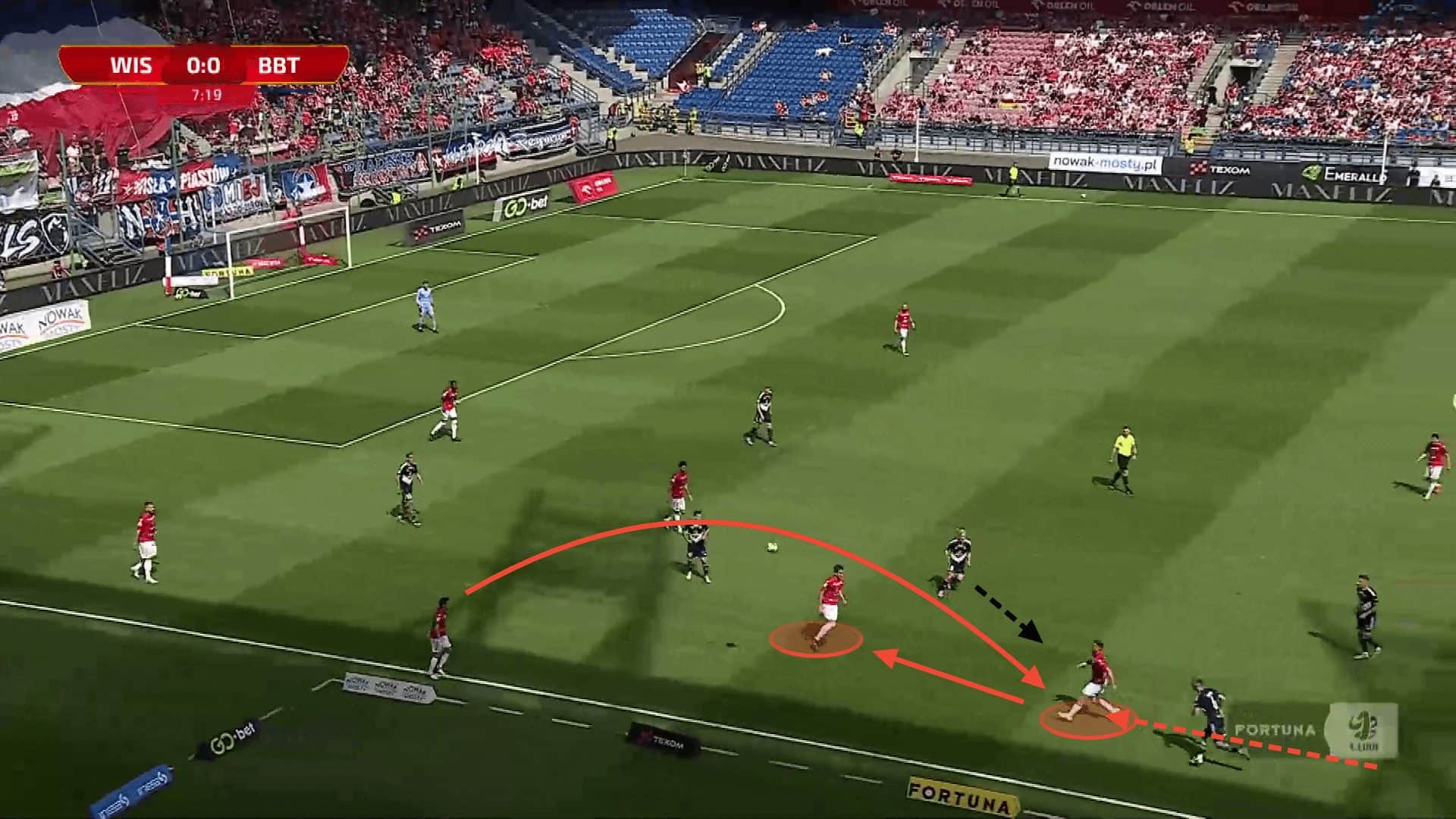
The next attacker makes a run into space, acting as the third man, while we can see that the player who has made the pass is able to do so without any opponents getting a foot in.
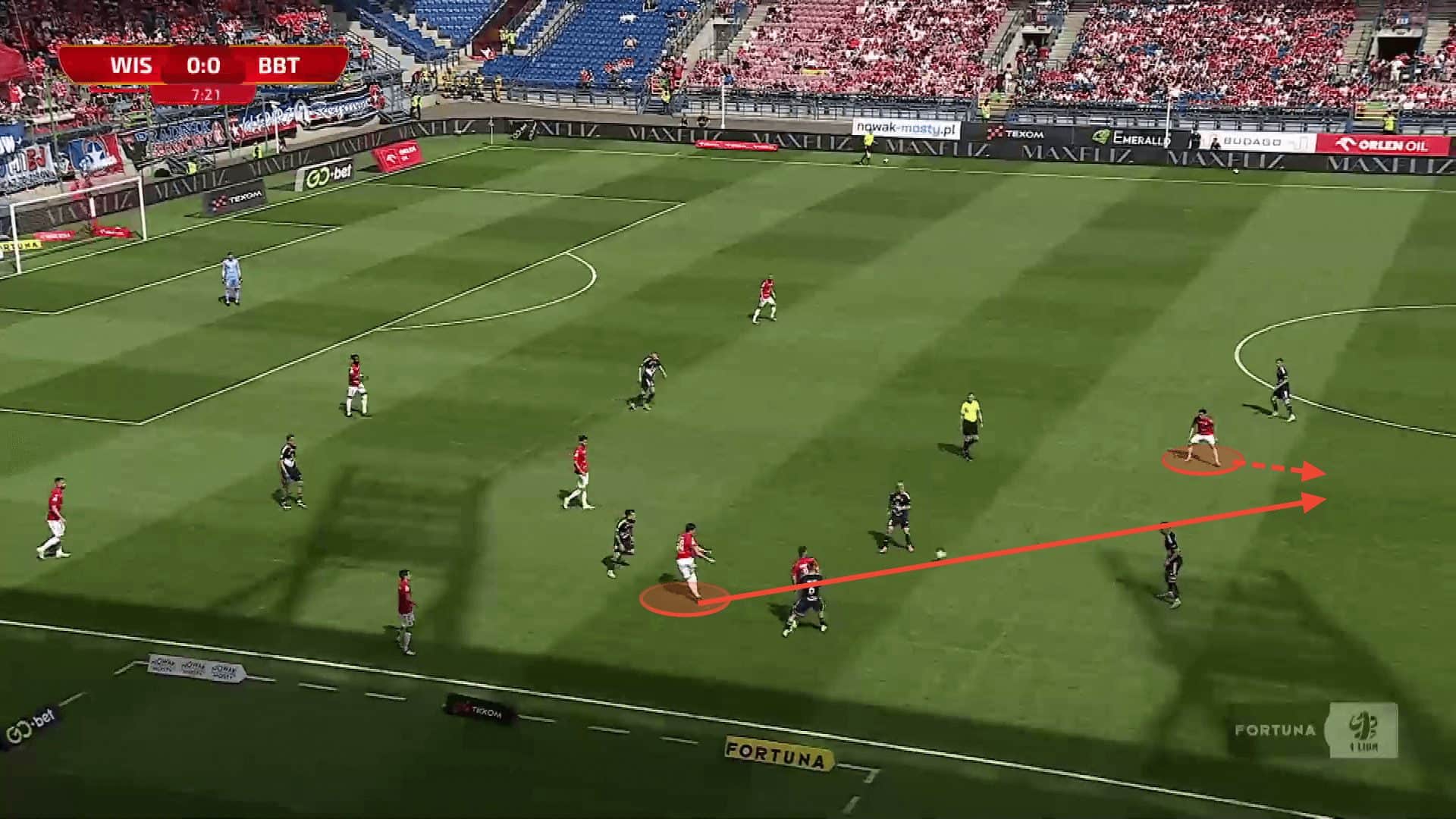
A common theme of successful possession retention is the skill of an attacker to hold the ball up while a defender is behind them. This enables the attacking side to put the ball into a dangerous area and gain territory there, even if the player isn’t in a threatening position to affect the game. It is important that when a player is holding the ball up, third-man runs are constantly made to provide forward attacking options in which the attacker can lay the ball off. In this particular example, like in a lot of throw-ins, the player taking the throw is usually left unmarked, meaning the ball can be returned to him and the ball can be in its original position, at the sideline with everyone in the same positions, but the only difference being the ball is in open play now.

The last thing a throw-in provides is the potential for a volley when receiving the ball in the air. As the ball travels in the air, it is simple for the attacker to volley the ball and switch the play. We always see during throw-ins, due to their limited range, opposition teams come into one side of the pitch, which frequently gives the attacking side the option of switching the ball immediately.
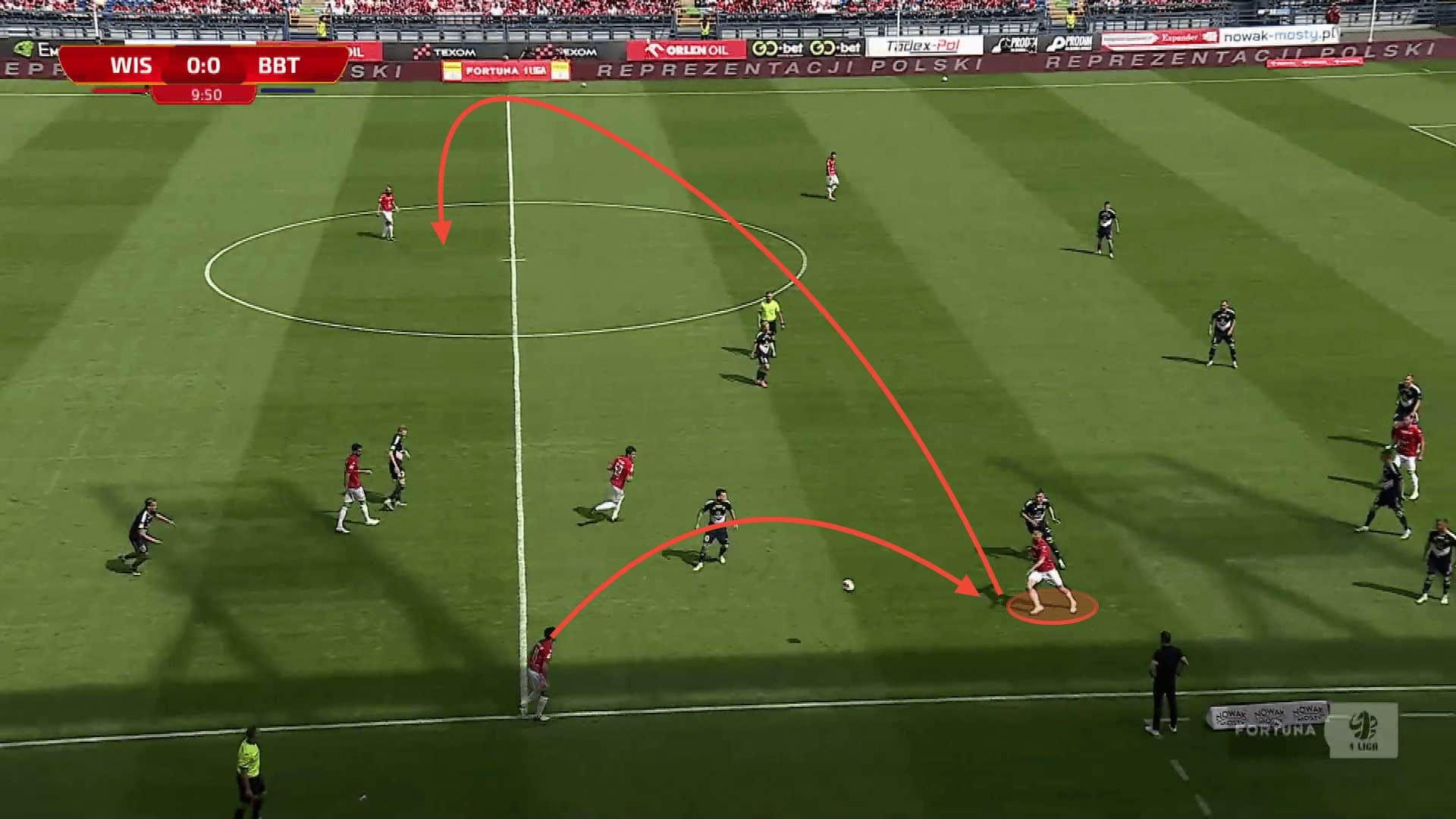
Summary
This tactical analysis has shown the different ways Thomas Grønnemark has been able to positively influence Wisła Kraków and Kolding IF to their respective success they achieved. Through teaching and developing different types of throws, increasing the length of the throw-in, and bettering the tactical understanding during throw-ins, Grønnemark has shown his value as a throw-in coach and why it is essential for every team to work on their throw-in routines.






Comments